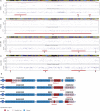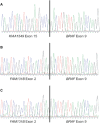Chromosome band 7q34 deletions resulting in KIAA1549-BRAF and FAM131B-BRAF fusions in pediatric low-grade Gliomas
- PMID: 25040262
- PMCID: PMC4282976
- DOI: 10.1111/bpa.12167
Chromosome band 7q34 deletions resulting in KIAA1549-BRAF and FAM131B-BRAF fusions in pediatric low-grade Gliomas
Abstract
The majority of pediatric low-grade gliomas (LGGs) are characterized by constitutive activation of the mitogen-activated protein kinase (MAPK) pathway through various mechanisms including BRAF mutations, inactivation of NF1, and KIAA1549-BRAF and FAM131B-BRAF fusions. The KIAA1549-BRAF fusion typically results from a 2.0 Mb tandem duplication in chromosome band 7q34. In the present study, single nucleotide polymorphism (SNP)-based array analysis of three LGGs demonstrated deletions in 7q34 that resulted in a BRAF fusion. Case 1 was likely a pilocytic astrocytoma (PA) with three deletions in 7q33q34 and an exon 15-9 KIAA1549-BRAF fusion. SNP array analysis of case 2, a possible dysembryoplastic neuroepithelial tumor (DNT), revealed a 2.6 Mb deletion, which included the 5' end of BRAF and extended to the 3' end of FAM131B. In case 3, deletions involving BRAF and FAM131B were observed in both a primary and a recurrent PA. RNA-based sequence analysis of cases 2 and 3 confirmed a fusion between FAM131B exon 2 and BRAF exon 9. The presence of fusion transcripts in these three LGGs highlights the utility of SNP array analysis to identify deletions that are suggestive of fusion proteins. BRAF fusions can result from multiple non-overlapping deletions, suggesting various complex mechanisms of formation.
Keywords: BRAF; FAM131B; KIAA1549; pediatric glioma.
© 2014 International Society of Neuropathology.
Figures





References
-
- Bar EE, Lin A, Tihan T, Burger PC, Eberhart CG (2008) Frequent gains at chromosome 7q34 involving BRAF in pilocytic astrocytoma. J Neuropathol Exp Neurol 67:878–887. - PubMed
-
- Cin H, Meyer C, Herr R, Janzarik WG, Lambert S, Jones DT et al (2011) Oncogenic FAM131B‐BRAF fusion resulting from 7q34 deletion comprises an alternative mechanism of MAPK pathway activation in pilocytic astrocytoma. Acta Neuropathol 121:763–774. - PubMed
-
- Colin C, Padovani L, Chappe C, Mercurio S, Scavarda D, Loundou A et al (2013) Outcome analysis of childhood pilocytic astrocytomas: a retrospective study of 148 cases at a single institution. Neuropathol Appl Neurobiol 39:693–705. - PubMed
Publication types
MeSH terms
Substances
Grants and funding
LinkOut - more resources
Full Text Sources
Other Literature Sources
Medical
Research Materials
Miscellaneous

